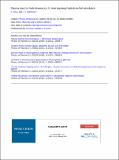Plasma electron hole kinematics. II. Hole tracking Particle-In-Cell simulation
Author(s)
Zhou, Chuteng; Hutchinson, Ian Horner
DownloadHutch IOP ZhouPoP2016.pdf (2.169Mb)
PUBLISHER_POLICY
Publisher Policy
Article is made available in accordance with the publisher's policy and may be subject to US copyright law. Please refer to the publisher's site for terms of use.
Terms of use
Metadata
Show full item recordAbstract
The kinematics of a 1-D electron hole is studied using a novel Particle-In-Cell simulation code. A hole tracking technique enables us to follow the trajectory of a fast-moving solitary hole and study quantitatively hole acceleration and coupling to ions. We observe a transient at the initial stage of hole formation when the hole accelerates to several times the cold-ion sound speed. Artificially imposing slow ion speed changes on a fully formed hole causes its velocity to change even when the ion stream speed in the hole frame greatly exceeds the ion thermal speed, so there are no reflected ions. The behavior that we observe in numerical simulations agrees very well with our analytic theory of hole momentum conservation and the effects of “jetting.”
Date issued
2016-08Department
Massachusetts Institute of Technology. Department of Nuclear Science and Engineering; Massachusetts Institute of Technology. Plasma Science and Fusion CenterJournal
Physics of Plasmas
Publisher
American Institute of Physics (AIP)
Citation
Zhou, C., and I. H. Hutchinson. “Plasma Electron Hole Kinematics. II. Hole Tracking Particle-In-Cell Simulation.” Physics of Plasmas 23, 8 (August 2016): 082102
Version: Final published version
ISSN
1070-664X
1089-7674